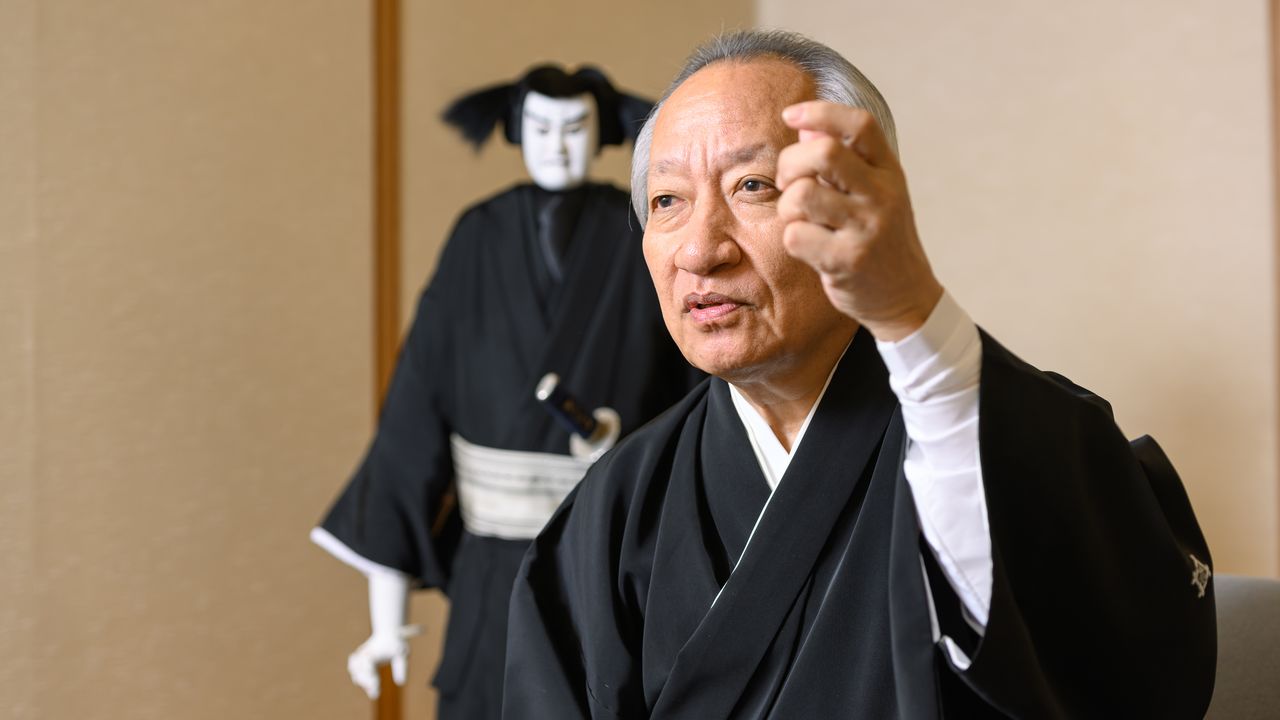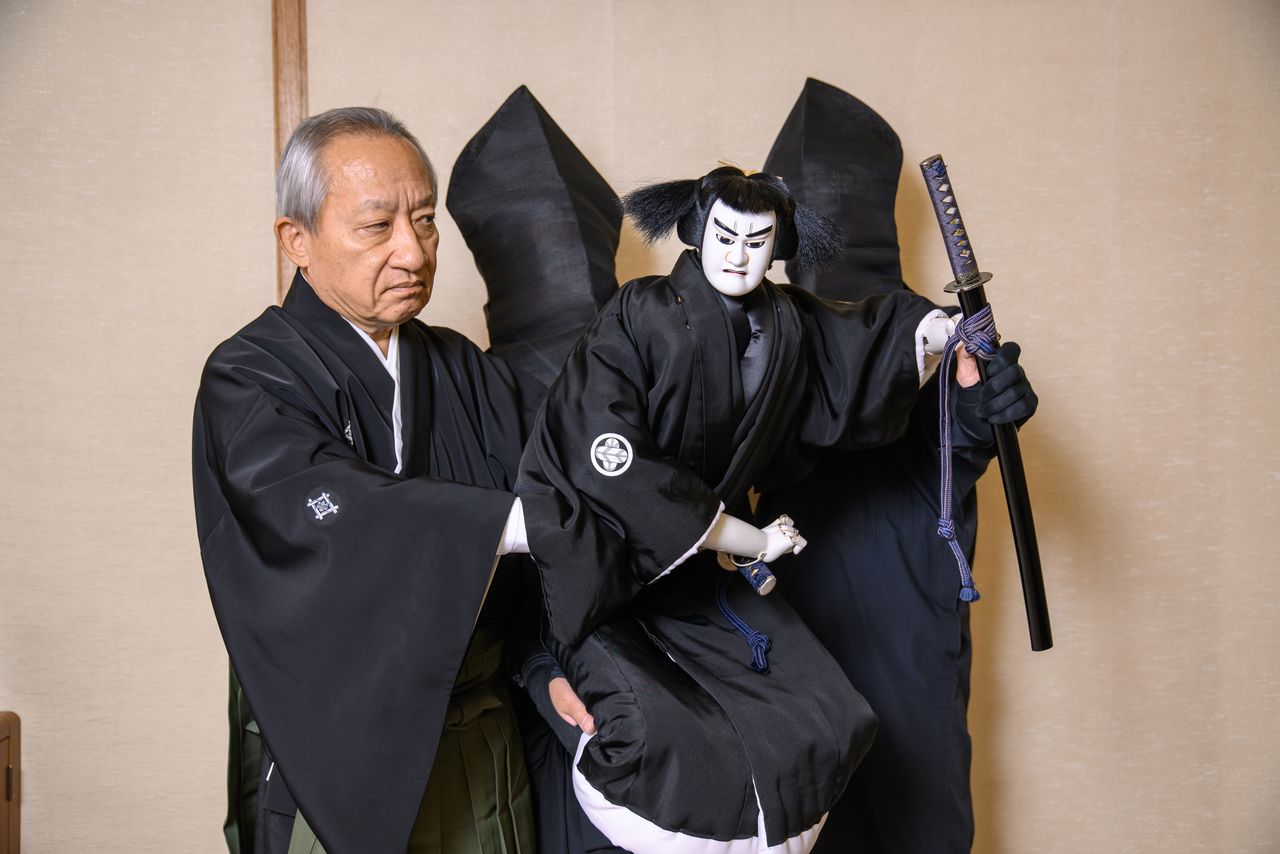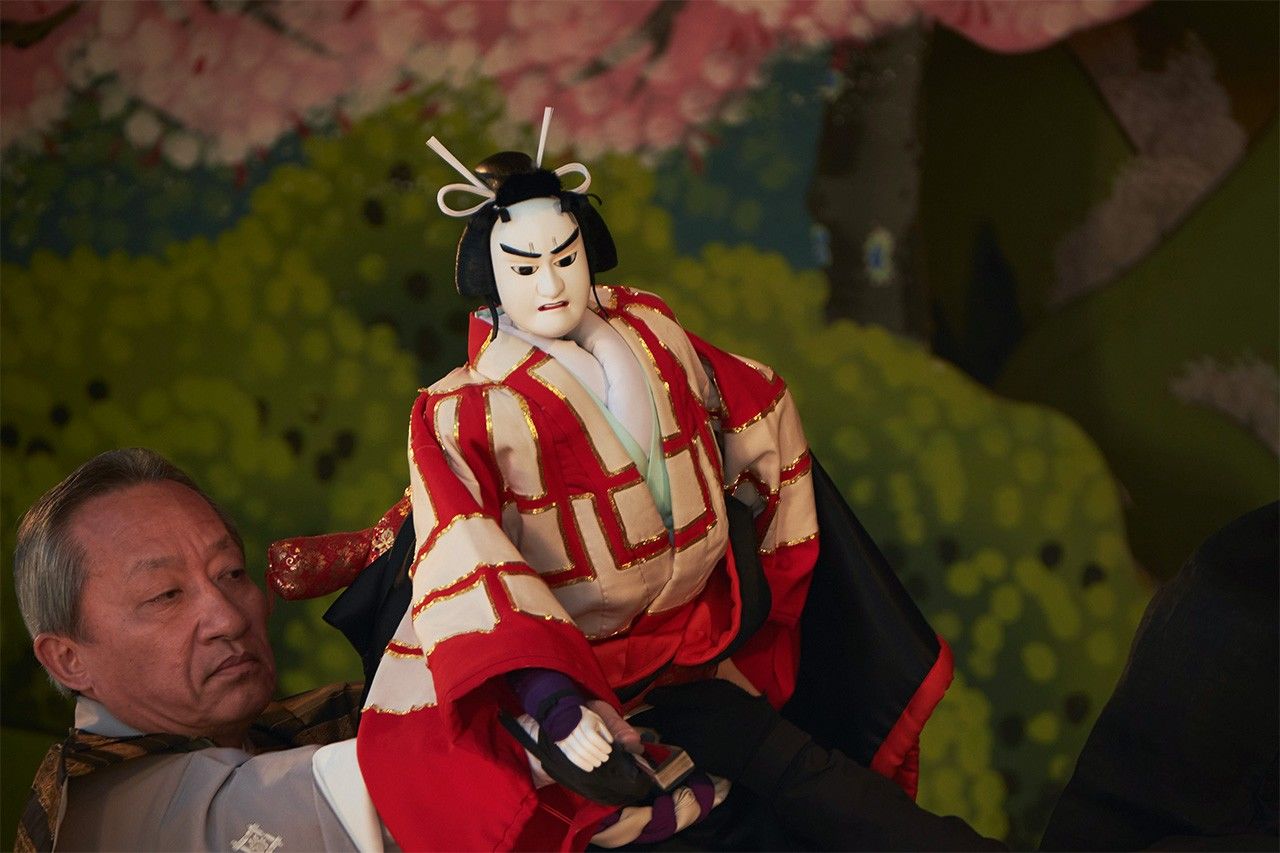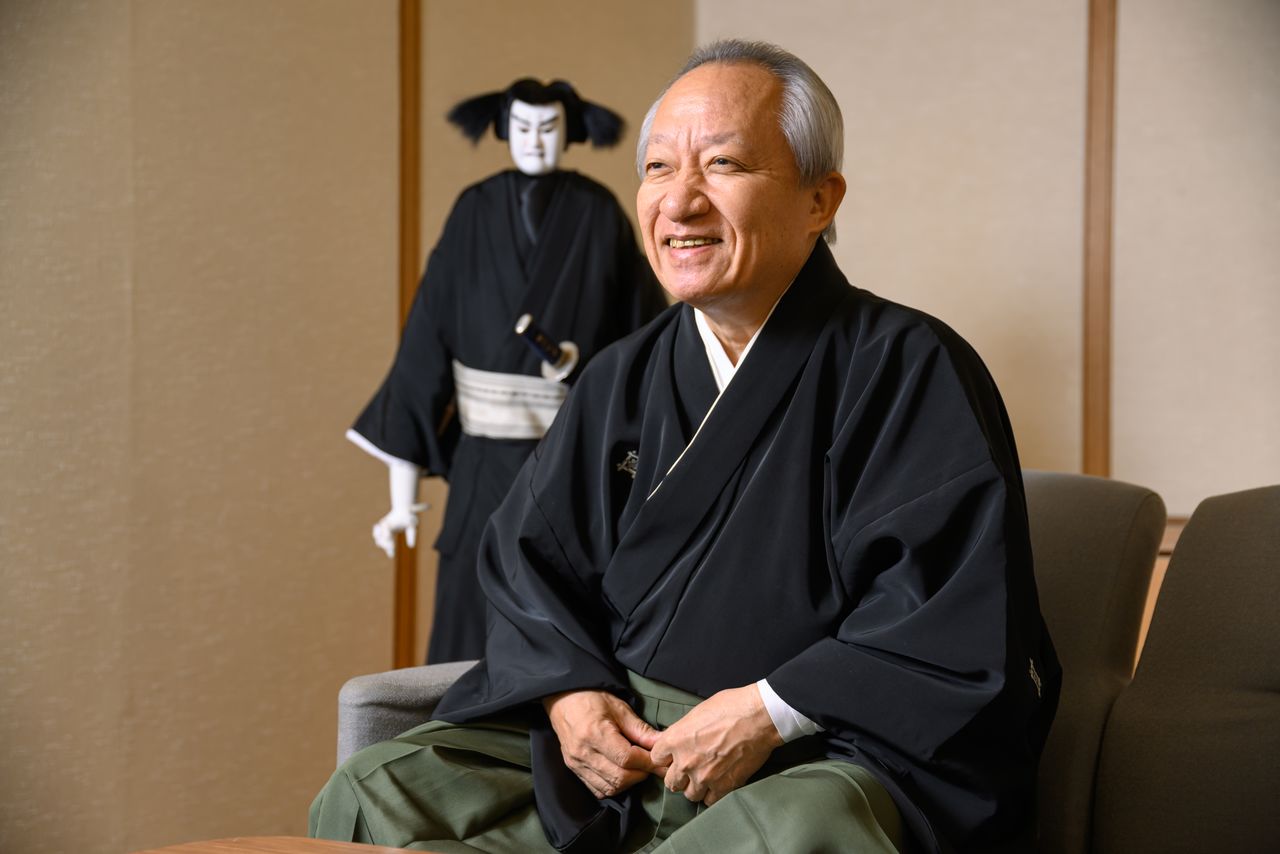
Kiritake Kanjūrō: Breathing Life into Bunraku Puppets
Culture History Work Entertainment- English
- 日本語
- 简体字
- 繁體字
- Français
- Español
- العربية
- Русский
Synchronizing One’s Breath
The November 2024 program at the National Bunraku Theater in Osaka featured the play Chūshingura: The Treasury of Loyal Retainers, originally written as an 11-act drama and considered one of the three great masterpieces of the bunraku repertoire. This classic is a moving tale of loyalty, sacrifice, and honor based loosely on the early-eighteenth-century Akō incident involving 47 rōnin who avenged the death of their lord.
The role performed by puppeteer Kiritake Kanjūrō was the tragic figure of Hayano Kanpei, a retainer who was absent from his lord’s side at the critical moment and unable to intervene. Since then, Kanpei has withdrawn to his wife’s home and is making a living as a hunter. His plight deepens when he mistakenly believes that he has shot his father-in-law in the dark of night, and he chooses to take his own life in despair.
Kanjūrō skillfully animates his puppet to convey Kanpei’s agony, which is amplified by the tayū’s impassioned narration and the shamisen’s musical accompaniment.
It is only after Kanpei has stabbed himself that he learns that the man he killed was actually not his father-in-law but a thief who had taken his father-in-law’s life. Cleared of wrongdoing, he gets to sign the ronin’s pledge of vengeance with his own blood before breathing his last. The moment life leaves Kanpei, the puppet goes limp in Kanjūrō’s hands.
“My breath has to be in sync with the puppet’s role,” Kanjūrō says. “If characters are holding their breath, then I do the same. And if they gasp, so do I. A warrior and a noblewoman will breathe differently, and unless I adjust my own breath accordingly, the puppets won’t look their parts.”
This synchronization not only gives life to a puppet but can also extinguish it when the character dies. “I’m quite fond of portraying characters who have been critically injured, like Kanpei. They usually don’t die right away—it can take fifteen to twenty minutes for them to finally succumb. They’re putting so much effort into each word and movement; as their breath gradually grows shallower, their shoulders begin to rise and fall. Working to get these small details right is really fascinating.”
A bunraku puppet is operated by three people working in unison: the omozukai, or main puppeteer, controls the head and right hand, while the hidarizukai operates the left hand and the ashizukai works the feet. Emotions and states of mind can be conveyed with striking realism through skillful coordination among the three. Just a tilt of the head or lifting of a finger can make a powerful impression.

Kiritake Kanjūrō holding the puppet of Hayano Kanpei. (© Mizuno Hiroshi)
“Having three people operate each puppet is what makes bunraku unique. For each production, we partner with different people with varying skill levels and experience. But we’re still able to coordinate our movements in perfect harmony because the omozukai is constantly sending signals to the other two puppeteers while onstage. This is what enables the distinctive motions of bunraku puppetry.”
From After-School Helper to Master Puppeteer
Becoming a full-fledged puppeteer is a rigorous journey—10 years handling the feet, 15 years the left hand, and only then reaching the level of omozukai. Kanjūrō set off on this path when he was just in seventh grade.
“My father was a puppeteer and asked me to help out one day because they were short-handed,” Kanjūrō recalls. “There was no rehearsal, and I was just told to hold the puppet’s feet. It was physically exhausting.”
A Merit-Based World
“There weren’t enough people to operate the puppets, so everyone was happy when I went to help out. After a while, I learned how to make the feet move as if alive, and I slowly got drawn in. My grades at school weren’t particularly good, so I told my father when I was in ninth grade that I’d rather become a puppeteer than go to high school.”
Unlike many other traditional arts, bunraku is strictly merit based, and having a well-known practitioner as a parent is no guarantee of success. And training can be grueling.
“Puppeteering is not something you can teach with words alone,” Kanjūrō points out. “So even if you ask, no one will tell you everything you want to know. You have to watch how other people do it, and you’re going to wind up making a lot of mistakes before you get it right. You start out by handling the feet, but this is physically very demanding. Especially when the character is just sitting still, you have to keep your hips lowered and head tilted back for a long time, which can be very strenuous. It really tests your endurance.”
Once one starts getting a feel for the various techniques, though, there is no turning back. “The best way to learn in the beginning is by working the feet. That’s because you’re positioned right next to the omozukai, so you can not only observe his movements—you can feel them. The more I learned, the less arduous the training became, and the more my passion for bunraku grew. I’m probably more in love with bunraku today than anyone else!”
Expanding Bunraku’s Potential
Kanjūrō apprenticed with Yoshida Minosuke III, who was designated a living national treasure in 1994. It was his father, Kiritake Kanjūrō II—conferred the honor in 1982—that made the choice of mentor. “One day, my father told me, ‘Go study under Minosuke,’ so that’s what I did.”
In a book published on the fiftieth anniversary of the start of his career, Kanjūrō writes of his teacher:
My master is a rare puppeteer who can transform himself into the character the moment he holds the puppet, but that’s not something I can do. If I forced myself to fit his mold, I would probably have given up this profession long ago. In fact, soon after I began training with him, he told me quite bluntly that I’d never be able to do what he does. “I can teach you everything I know, but you still wouldn’t be able to do it,” he said. “So, you’re going to have to find your own path.” I’m truly grateful that he shared this insight with me.
Thanks to this advice, Kanjūrō established his own style, honing his art and earning the title of living national treasure himself in 2021—a remarkable achievement spanning two generations, both as parent and child and as master and apprentice. He was cited for his masterful embodiment of the traditional techniques of bunraku puppetry, as demonstrated in his skills portraying a wide range of roles, both female and male.
“I’ve been working as a puppeteer for nearly sixty years now, so on a personal level, there’s really nothing that I still need to learn. But with regard to working as a three-person team in operating the puppets, I feel there’s potential waiting to be tapped. It’s an amazingly effective system that evolved over the centuries, and improving on it will be a formidable task, but I’ve always enjoyed taking on new challenges.”
Kanjūrō’s recent initiatives include creating new works and collaborating across genres. In 2024, he supervised a groundbreaking production that integrated animation into stage design, which made a successful tour of five US cities.
“The performing arts wouldn’t exist without an audience, but the size of bunraku’s fan base, unfortunately, isn’t very large at the moment. This is a serious problem, and I hope more people can come to our performances. I’m sure that once they do, they’ll want to see more. On our part, we have to bolster our promotional efforts and make sure to pass our skills to the next generation. We have a lot of work to do.”

Kiritake Kanjūrō performing the role of Kitsune Tadanobu in Yoshitsune and the Thousand Cherry Trees at Nippon Bunraku, held in March 2017 at Ise Shrine. (Photo by Kitchen Minoru)
Referenced Works
- Kanadehon chūshingura (trans. as Chūshingura: The Treasury of Loyal Retainers by Donald Keene)
- Yoshitsune senbon-zakura (trans. as Yoshitsune and the Thousand Cherry Trees by Stanleigh Jones Jr.)
(Originally published in Japanese. Interview and text by Sugihara Yuka and Power News. Banner photo © Mizuno Hiroshi.)


